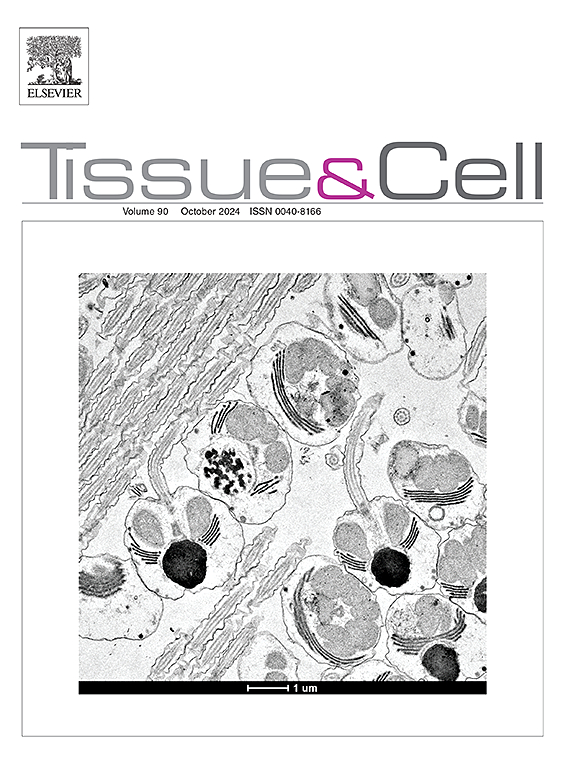IF 2.7
4区 生物学
Q1 ANATOMY & MORPHOLOGY
引用次数: 0
摘要
背景已证实甲状腺乳头状癌(PTC)组织中金属硫蛋白1 G(MT1G)存在下调。方法 通过实时定量 PCR 检测 MT1G 和甲基转移酶样 3 (METTL3) mRNA 水平。Western印迹法检测MT1G、METTL3、Wnt3A和β-catenin的蛋白水平。细胞增殖、凋亡、侵袭和迁移通过细胞计数试剂盒 8 检测、菌落形成检测、EdU 检测、流式细胞术、Transwell 检测和伤口愈合检测进行测定。MeRIP分析用于检测MT1G甲基化。使用 RIP 检测法和双荧光素酶报告器检测法评估了 METTL3 和 MT1G 之间的相互作用。结果MT1G在PTC中表达下调,过表达抑制了PTC细胞的生长、侵袭和迁移。METTL3调控的m6A修饰增强了MT1G mRNA的稳定性。METTL3 的过表达抑制了 PTC 细胞的生长和转移,而 MT1G 的敲除逆转了这一效应。此外,METTL3/MT1G轴可抑制Wnt/β-catenin通路的活性。结论 METTL3介导的对MT1G的m6A修饰可通过使Wnt/β-catenin通路失活来抑制PTC细胞的生长和转移。本文章由计算机程序翻译,如有差异,请以英文原文为准。
METTL3-mediated m6A modification of MT1G inhibits papillary thyroid carcinoma cell growth and metastasis via Wnt/β-catenin pathway
Background
Downregulation of metallothionein 1 G (MT1G) has been demonstrated in papillary thyroid carcinoma (PTC) tissues. However, the underlying molecular mechanisms of MT1G in PTC progression need to be further explored.
Methods
MT1G and methyltransferase-like 3 (METTL3) mRNA levels were tested by quantitative real-time PCR. The protein levels of MT1G, METTL3, Wnt3A and β-catenin were measured by western blot. Cell proliferation, apoptosis, invasion and migration were measured by cell counting kit 8 assay, colony formation assay, EdU assay, flow cytometry, transwell assay and wound healing assay. MeRIP analysis was used to detect the MT1G methylation. The interaction between METTL3 and MT1G was evaluated using RIP assay and dual-luciferase reporter assay. A mouse xenograft model was also constructed to explore the roles of METTL3 and MT1G in vivo.
Results
MT1G expression was downregulated in PTC, and its overexpression suppressed PTC cell growth, invasion and migration. METTL3-regulated m6A modification enhanced MT1G mRNA stability. Overexpression of METTL3 repressed PTC cell growth and metastasis, and this effect was reversed by MT1G knockdown. Besides, METTL3/MT1G axis could inhibit the activity of Wnt/β-catenin pathway. Meanwhile, METTL3 enhanced MT1G expression to suppress PTC tumor growth through Wnt/β-catenin pathway in vivo.
Conclusion
METTL3-mediated m6A modification of MT1G inhibited PTC cell growth and metastasis via inactivating the Wnt/β-catenin pathway.
求助全文
通过发布文献求助,成功后即可免费获取论文全文。
去求助
来源期刊

Tissue & cell
医学-解剖学与形态学
CiteScore
3.90
自引率
0.00%
发文量
234
期刊介绍:
Tissue and Cell is devoted to original research on the organization of cells, subcellular and extracellular components at all levels, including the grouping and interrelations of cells in tissues and organs. The journal encourages submission of ultrastructural studies that provide novel insights into structure, function and physiology of cells and tissues, in health and disease. Bioengineering and stem cells studies focused on the description of morphological and/or histological data are also welcomed.
Studies investigating the effect of compounds and/or substances on structure of cells and tissues are generally outside the scope of this journal. For consideration, studies should contain a clear rationale on the use of (a) given substance(s), have a compelling morphological and structural focus and present novel incremental findings from previous literature.
 求助内容:
求助内容: 应助结果提醒方式:
应助结果提醒方式:


